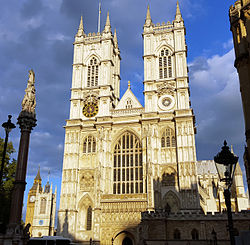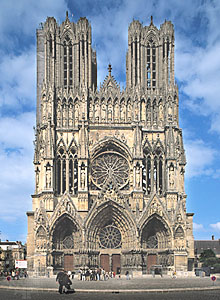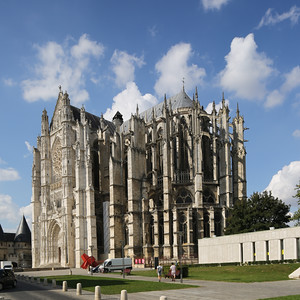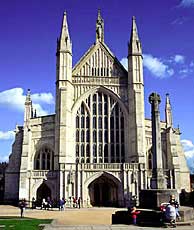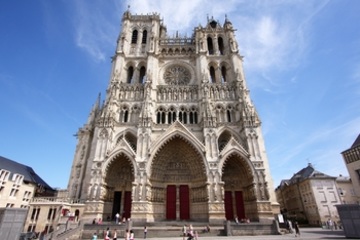The Gothic Architecture Quiz: Trivia Facts!
-
One of the oldest french gothic church. it was begun by Bishop Maurice de Sully.
-
Winchester cathedral
-
Notre dame, paris
-
Westminster abbey
-
Rhiems
-
Do you know anything about gothic architecture? Gothic architecture is an architectural style that thrived in Europe during the high and late middle ages. It came to fruition in the 12th century Northern France and England. The distinguishing element of Gothic architecture is the work done in churches, and they also built many cherished cathedrals. Taking this quiz will help you see how much you know about gothic architecture. Take this quiz and learn more about gothic architecture.
(173).jpg)
Quiz Preview
- 2.
A carved or molded grotesque figure protruding from the top of a wall designed to carry out water.
Explanation
A gargoyle is a decorative architectural feature commonly found on buildings, especially Gothic cathedrals. It is a carved or molded grotesque figure that is positioned on the top of a wall. The primary purpose of a gargoyle is to function as a water spout, diverting rainwater away from the building's walls to prevent damage. However, they also serve an ornamental purpose, adding a unique and sometimes intimidating aesthetic to the structure. Gargoyles are often depicted as mythical creatures or animals and have become iconic symbols of Gothic architecture.Rate this question:
- 3.
Circular window delineated with often highly complex tracery that gives it the appearance of a multipetalled rose.
Explanation
A rose window is a circular window that is often decorated with intricate and complex designs, resembling the petals of a rose. The tracery, or the decorative stone work, on the window adds to its beauty and gives it a unique appearance. The term "rose window" is used to describe this specific type of circular window with elaborate tracery.Rate this question:
- 4.
The crowning ornament of a pinnacle spire or roof.
Explanation
A finial is a decorative ornament that is typically placed on top of a pinnacle, spire, or roof. It adds a finishing touch and enhances the overall aesthetic of the structure. Finials are often designed in various shapes and styles, such as a ball, a cross, or a floral motif. They serve both a functional and decorative purpose, providing a visually appealing element while also helping to protect the structure from weathering.Rate this question:
- 5.
A masonry structure providing support to a wall.
Explanation
A buttress is a masonry structure that is used to provide support to a wall. It is typically built against the exterior of a wall and helps to reinforce and stabilize it. Buttresses are often seen in the architecture of cathedrals and other large buildings, where they are used to counteract the lateral forces exerted on the walls. They can be designed in various shapes and sizes depending on the specific needs of the structure.Rate this question:
- 6.
One of the largest Benedictine monasteries. comprises an abbey church and a square cloister court. it was built by several master masons and master carpenters. it is geometrically in style w/ pinnacles and tracery windows.
-
Winchester cathedral
-
Westminster abbey
-
York
-
Rheims
Correct Answer
A. Westminster abbeyExplanation
Westminster Abbey is the correct answer because it is one of the largest Benedictine monasteries and it consists of an abbey church and a square cloister court. It was constructed by multiple master masons and master carpenters. The architectural style of Westminster Abbey is geometric, featuring pinnacles and tracery windows.Rate this question:
-
- 7.
Coronation church of France, west facade is famous for its 500 statues.
-
Chartres cathedral
-
Rhiems cathedral
-
Amiens cathedral
-
Beauvais cathedral
Correct Answer
A. Rhiems cathedralExplanation
The correct answer is Rhiems Cathedral. The west facade of Rhiems Cathedral is famous for its 500 statues.Rate this question:
-
- 8.
Famous for its 160 stained glass windows:
-
Chartres cathedral
-
Rhiems cathedral
-
Amiens cathedral
-
Beauvais cathedral
Correct Answer
A. Chartres cathedralExplanation
Chartres Cathedral is famous for its 160 stained glass windows. The cathedral is renowned for its exceptional stained glass collection, which spans from the 12th to the 13th century. These windows depict biblical stories and scenes from the lives of saints, and they are considered masterpieces of medieval art. The stained glass windows of Chartres Cathedral are admired for their vibrant colors, intricate details, and the way they capture and transmit light, creating a truly awe-inspiring experience for visitors.Rate this question:
-
- 9.
Famous for its 500 statues.
-
Winchester cathedral
-
Westminster abbey
-
York
-
Rheims
Correct Answer
A. RheimsExplanation
Rheims is famous for its 500 statues.Rate this question:
-
- 10.
The largest cathedral in northern Europe covering with approx. area of 91,000 sq. m.
-
S. elizabeth marburge
-
Cologne cathedral
-
Limburg cathedral
-
St. etienne, bourges cathedral
Correct Answer
A. Cologne cathedralExplanation
Cologne Cathedral is the correct answer because it is the largest cathedral in northern Europe with an approximate area of 91,000 sq. m. The other options, S. Elizabeth Marburge, Limburg Cathedral, and St. Etienne, Bourges Cathedral, do not hold the distinction of being the largest cathedral in northern Europe.Rate this question:
-
- 11.
Has a palace w/c was the headquarters of the Popes.
-
Caracassone
-
Avignon
-
Roven
-
Floating castle
Correct Answer
A. AvignonExplanation
Avignon is the correct answer because it is known for having a palace that was the headquarters of the Popes. The Palais des Papes, located in Avignon, was the residence of the Popes in the 14th century and served as the center of the Catholic Church during that time. It is a significant historical and architectural landmark, attracting tourists from around the world.Rate this question:
-
- 12.
Considered w/ loftiest vaults in Europe at 157 ft. and 6 inches.
-
Chartres cathedral
-
Rhiems cathedral
-
Amiens cathedral
-
Beauvais cathedral
Correct Answer
A. Beauvais cathedralExplanation
Beauvais Cathedral is considered to have the loftiest vaults in Europe at a height of 157 ft. and 6 inches. This means that the ceilings of Beauvais Cathedral are higher than those of Chartres Cathedral, Rhiems Cathedral, and Amiens Cathedral. The height of the vaults in Beauvais Cathedral is a notable architectural feature that sets it apart from the other cathedrals mentioned.Rate this question:
-
- 13.
Has the greatest total length (560 ft.) than-any medieval cathedral.
-
Winchester cathedral
-
Westminster abbey
-
York
-
Rheims
Correct Answer
A. Winchester cathedralExplanation
Winchester Cathedral has the greatest total length of 560 ft, making it longer than any other medieval cathedral listed.Rate this question:
-
- 14.
The counterpart of Salisbury of England, famous for its carved woodwork in the choir stalls. designed by Robert de lurches.
-
Chartres cathedral
-
Rhiems cathedral
-
Amiens cathedral
-
Beauvais cathedral
Correct Answer
A. Amiens cathedralExplanation
The correct answer is Amiens Cathedral. Amiens Cathedral is known for its carved woodwork in the choir stalls, which were designed by Robert de Lurches. It is the counterpart of Salisbury Cathedral in England, which also has notable woodwork. Chartres Cathedral, Reims Cathedral, and Beauvais Cathedral are all famous cathedrals in France, but they are not specifically known for their carved woodwork in the choir stalls.Rate this question:
-
- 15.
A low protective wall running along the edge of the roof.
Correct Answer
ParapetExplanation
A parapet is a low protective wall that runs along the edge of a roof. It serves as a barrier to prevent people from falling off the roof and also provides some protection from wind and other elements. Parapets are commonly found on buildings with flat roofs or rooftops that are accessible to the public. They can be made of various materials such as brick, stone, or concrete, and can have decorative elements or be plain and functional.Rate this question:
- 16.
Largest medieval cathedral in Europe 2nd largest in the world.
-
S. elizabeth marburge
-
Cologne cathedral
-
Seville cathedral spain
-
St. etienne, bourges cathedral
Correct Answer
A. Seville cathedral spainExplanation
Seville Cathedral in Spain is the correct answer because it is the largest medieval cathedral in Europe and the second largest in the world. This means that it surpasses the other options mentioned, such as Cologne Cathedral and St. Etienne, Bourges Cathedral, in terms of size and grandeur.Rate this question:
-
- 17.
Part of the tower where the bells are hung.
Correct Answer
BelfryExplanation
A belfry is a part of a tower where the bells are hung. It is typically a separate structure or room within the tower that houses the bells and provides a space for them to be rung. The belfry is usually located at the top of the tower, allowing the sound of the bells to carry over a long distance. The word "belfry" comes from the Old French word "berfrei" which means a tower or turret for bells.Rate this question:
- 18.
A narrow, tall structure, here projecting from the crossing or west end of the church.
Correct Answer
TowerExplanation
The given definition describes a structure that is narrow and tall, typically found at the crossing or west end of a church. This structure is commonly known as a tower.Rate this question:
- 19.
The usually triangular part of the wall enclosing the sloping faces of a pitched roof.
Correct Answer
GableExplanation
A gable is the triangular part of a wall that is formed by the sloping faces of a pitched roof. It is typically found at the ends of a building, where the roof slopes down from a peak to the eaves. The gable provides structural support to the roof and also adds aesthetic appeal to the overall design of the building. It is a distinctive feature commonly seen in traditional architectural styles.Rate this question:
- 20.
The roughly triangular space created between the outer side of an arch's curve.
Correct Answer
SpandrelExplanation
The term "spandrel" refers to the roughly triangular space that is formed between the outer side of an arch's curve. In architecture, this space is often filled with decorative elements or left open for aesthetic purposes. The spandrel serves as a transition between the arch and the surrounding structure, providing support and adding visual interest to the design.Rate this question:
- 21.
A small gable used to top a buttress.
Correct Answer
gabletExplanation
A gablet is a small gable that is used to top a buttress. A gable is a triangular portion of a wall between the edges of a dual-pitched roof, and a buttress is a support structure that projects from a wall to provide additional strength. Therefore, a gablet is a decorative element that is placed on top of a buttress, adding aesthetic appeal to the structure.Rate this question:
- 22.
Surrounded by moat water.
-
Caracassone
-
Avignon
-
Roven
-
Floating castle
Correct Answer
A. CaracassoneExplanation
Caracassone is the correct answer because it is a fortified city in France that is surrounded by a moat. The moat water acts as a defensive barrier, making it harder for enemies to attack the city. This feature is unique to Caracassone and distinguishes it from the other options listed.Rate this question:
-
- 23.
Largest in area and width in any English medieval cathedral.
-
Winchester cathedral
-
Westminster abbey
-
York
-
Reims
Correct Answer
A. YorkExplanation
York is the correct answer because it is known for having the largest area and width among all English medieval cathedrals. While Winchester Cathedral and Westminster Abbey are also famous cathedrals in England, they do not hold the title for being the largest in terms of area and width. Reims, on the other hand, is a cathedral located in France and is not relevant to the question.Rate this question:
-
- 24.
A tracery formed from a series of continuously curving bars.
Correct Answer
Curvilinear tracery
flowing traceryExplanation
Curvilinear tracery and flowing tracery both refer to a type of architectural design characterized by a series of continuously curving bars. This type of tracery is often found in Gothic architecture, where it adds a sense of fluidity and elegance to windows, arches, and other decorative elements. The use of curvilinear and flowing lines in tracery creates a sense of movement and harmony in the overall design, enhancing the aesthetic appeal of the structure.Rate this question:
- 25.
An elongated triangular form, narrowing towards the top and extending to the air.
Correct Answer
PinnacleExplanation
The correct answer is "Pinnacle." A pinnacle is an elongated triangular form that narrows towards the top and extends into the air. It is often used to describe a tall, pointed structure or peak, such as the top of a mountain or the spire of a building. The word "pinnacle" implies a sense of height, prominence, and grandeur.Rate this question:
- 26.
Characteristics example of a "hall church"
-
S. elizabeth marburge
-
Cologne cathedral
-
Limburg cathedral
-
St. etienne, bourges cathedral
Correct Answer
A. S. elizabeth marburge -
- 27.
A window piercing the outer wall of the aisles.
Correct Answer
clerestory window, Clerestory windowExplanation
The term for a window piercing the outer wall of the aisles in a building, particularly in the context of a church or cathedral, is a clerestory window. These are high windows above eye level that help to bring natural light deep into the interiors, especially in large spaces like nave aisles. They are often used in the upper levels of the nave, above the roofs of the side aisles.Rate this question:
- 28.
A bracket projecting from a wall to support a structure alone.
Correct Answer
CorbelExplanation
A corbel is a bracket that projects from a wall to support a structure alone. It is commonly used in architecture to provide additional support for structures such as beams or balconies. The corbel is typically made of stone, wood, or metal and is designed to bear the weight of the structure above it. This architectural element has been used for centuries and can be found in various styles of buildings around the world.Rate this question:
- 29.
An exterior set of steps leading to a grand entranceway or portal.
Correct Answer
PerronExplanation
A perron refers to an exterior set of steps leading to a grand entranceway or portal. It is a term commonly used in architecture to describe a flight of steps that provide access to an elevated entrance or platform. The word "perron" is derived from the French language and is often used to describe the entrance of a prominent building or a distinguished residence.Rate this question:
- 30.
A window piercing the upper storey of the nave, transepts, and looking over the aisle roof.
Correct Answer
Clerestory WindowExplanation
A clerestory window is a type of window that is located in the upper storey of a building, such as a nave or transept. It is positioned in a way that it pierces through the wall and overlooks the roof of the lower aisle. This type of window is designed to let in natural light and provide ventilation to the upper part of the building. It is often found in churches or other large buildings with high ceilings.Rate this question:
- 31.
The Sphere-shaped crowning ornament of a pinnacle.
Correct Answer
Orb FinialExplanation
An orb finial is a sphere-shaped crowning ornament that is typically placed on top of a pinnacle. It adds a decorative element to the structure and gives it a finished look. The orb shape symbolizes completeness and perfection, making it a fitting choice for the top of a pinnacle.Rate this question:
- 32.
A window giving light to a crypt.
Correct Answer
Undercroft window, crypt windowExplanation
A window that gives light to a crypt is typically referred to as a crypt window. These are usually small and placed low on the walls to provide light to the underground or partially underground space of a crypt, which is commonly found beneath churches or cathedrals.Rate this question:
- 33.
A small dormer window set into a spire often louvered.
Correct Answer
LucarneExplanation
A lucarne is a small dormer window that is typically set into a spire and is often louvered. This architectural feature is commonly used to provide ventilation and natural light to attic spaces or upper floors of a building. The term "lucarne" is derived from French and is commonly used in architectural terminology.Rate this question:
- 34.
A window shape formed by tracery using eight foils.
Correct Answer
Octofoil WindowExplanation
An octofoil window is a window shape formed by tracery using eight foils. Tracery refers to the ornamental stonework or ironwork that forms a pattern or design within a window. In this case, the tracery creates a window shape with eight foils, which are the individual curved sections within the window frame. The term "octofoil" is derived from the Latin words "octo" meaning eight, and "foil" referring to the curved sections. Therefore, an octofoil window is a specific type of window design characterized by its eight foils arranged in a symmetrical pattern.Rate this question:
- 35.
A column composed of several shafts.
Correct Answer
Clustered ColumnExplanation
A clustered column is a type of chart that displays multiple columns side by side, representing different categories or groups. In this case, the column is composed of several shafts, indicating that there are multiple shafts grouped together in the chart. This term accurately describes the visual representation of the data, making it the correct answer.Rate this question:
- 36.
Ornamental stonework set within the aperture of a window.
Correct Answer
Curvilinear TraceryExplanation
Curvilinear tracery refers to the ornamental stonework that is set within the aperture of a window. This type of tracery is characterized by its flowing and curved lines, creating intricate and decorative patterns. It is commonly found in Gothic architecture, where it adds a sense of elegance and beauty to the windows. The term "curvilinear" emphasizes the use of curves and arcs in the design, distinguishing it from other types of tracery that may feature straight lines or more geometric patterns. Overall, curvilinear tracery is a key element in window design, enhancing the aesthetic appeal of the architectural structure.Rate this question:
- 37.
A large entranceway composed of three openings typically found at the west end of medieval cathedrals.
Correct Answer
Tri-partite Portal
Tripartite PortalExplanation
A tri-partite portal refers to a large entranceway composed of three openings commonly found at the west end of medieval cathedrals. This architectural feature is characterized by its division into three distinct sections or compartments. The term "tri-partite" indicates the presence of three parts or divisions within the portal. The use of such portals in medieval cathedrals served both functional and symbolic purposes, providing a grand entrance while also representing the Holy Trinity.Rate this question:
- 38.
A statue set in an arched recess in a wall surface.
Correct Answer
Niche with statueExplanation
The correct answer is "Niche with statue" because a niche is a recess in a wall that is often used to display a statue or other decorative objects. In this context, the statue is set within an arched recess in the wall surface, which perfectly fits the description of a niche with a statue.Rate this question:
- 39.
A series of arched recesses in a wall designed to hold statues or simply provide surface variegation.
Correct Answer
Arcade of nichesExplanation
An arcade of niches refers to a series of arched recesses in a wall that are specifically designed to hold statues or provide decorative variation on the surface. This architectural feature is commonly found in buildings and structures where statues or decorative elements are desired. The term "arcade" refers to a series of arches, while "niches" are the recessed areas within the arches where statues or decorative items can be placed. The combination of these two elements creates an arcade of niches, which serves both functional and aesthetic purposes in architectural design.Rate this question:
Quiz Review Timeline (Updated): May 13, 2024 +
Our quizzes are rigorously reviewed, monitored and continuously updated by our expert board to maintain accuracy, relevance, and timeliness.
-
Current Version
-
May 13, 2024Quiz Edited by
ProProfs Editorial Team -
Aug 24, 2016Quiz Created by
Markmolato1988
Fauvism And Primitivism Quiz
Are you an art lover and understand different types of art? Would you like to test your knowledge with the fauvism and primitivism quiz? Art is a universal language, and it...
Questions:
10 |
Attempts:
323 |
Last updated:
Dec 15, 2022
|
Asian Art: China And Korea Quiz
How much do you know about Asian art, mainly of two countries, China and Korea? Would you like to try this "Asian Art: China and Korea Quiz" out and test your knowledge?...
Questions:
10 |
Attempts:
177 |
Last updated:
Dec 15, 2022
|
Southeast Asian Art: India, Nepal, And Tibet Quiz
Have you ever visited the southeastern part of Asia? Or do you live there? We have created the 'Southeast Asian Art: India, Nepal and Tibet Quiz' to check your knowledge...
Questions:
10 |
Attempts:
152 |
Last updated:
Dec 16, 2022
|
How Well Do You Know The Aestheticism Movement?
Are you a history lover? How well you know the aestheticism movement? Can you pass this quiz? The aestheticism movement is described as the 19th-century movement that focused on...
Questions:
10 |
Attempts:
206 |
Last updated:
Nov 16, 2023
|
First Monthly Examination In MAPEH
This examination assesses knowledge in music and arts, featuring questions on sounds from humans, nature, and musical instruments.
Questions:
30 |
Attempts:
65 |
Last updated:
Mar 20, 2023
|
CULTURAL AND CREATIVE ART
For qualitative learning and assessment, there shall be disqualification of learners for multiple submission. Ensure you review before submitting. Note : Writing of notes and...
Questions:
13 |
Attempts:
282 |
Last updated:
Mar 16, 2023
|
|
 Back to top
Back to top



